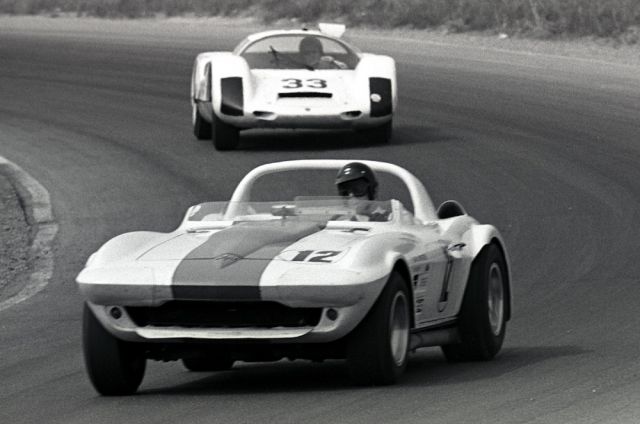posted
@ www.streetlegaltv.com
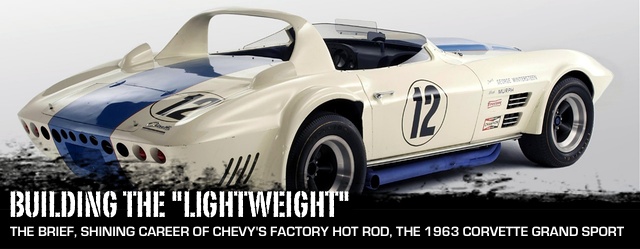
Modern supercars like the Ford GT, Nissan GT-R, and Lamborghini Gallardo LP550-2 Balboni have that kind of power. But what if I specified a year; say, 1963? For some readers, this year already rings a bell.
It is an important and yet almost mythical year in the Corvette’s history. It’s the beginning of the second generation, and the brief moment when the classic split window was produced. But most importantly, it is the year of “The Lightweight.”
A GS for Your Garage?
Not all of us have a couple million dollars burning a hole in our pockets, and even if we did, the five people who own these cars are not likely to put their cars up on eBay. So how does an enthusiast own one for themselves?
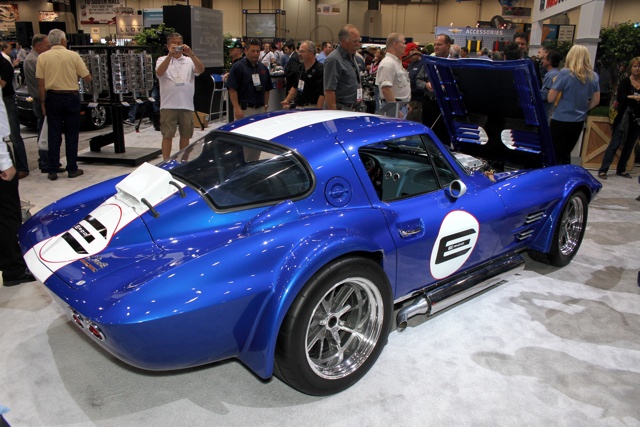
Today there are companies that sell reproduction and even licensed kit cars. These aren’t your typical backyard project either. These are built from the ground-up using many modern components for safety, reliability, and pure awesomeness.
Regardless if you buy one from Superformance or Mongoose Motorsports, these replicas typically come with tube-frame chassis, fully independent front and rear suspensions with coilovers, power steering, disk brakes all around, modern running gear from C4s or C5s, and buyer’s choice of engine. Price? Under $100k in most cases, not including your own sweat equity.
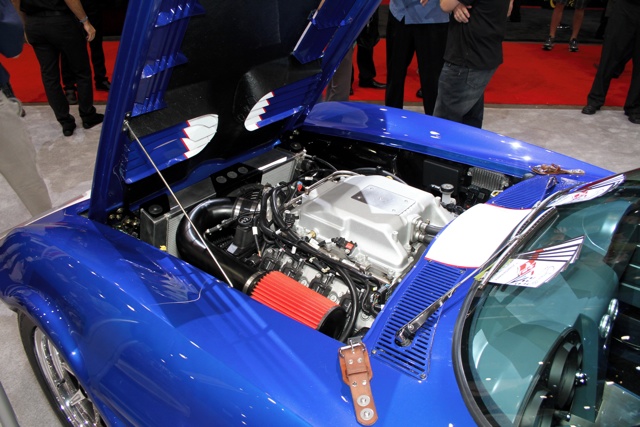
Not all of us have a couple million dollars burning a hole in our pockets, and even if we did, the five people who own these cars are not likely to put their cars up on eBay. So how does an enthusiast own one for themselves?

General Motors selected a Superformance GS replica to showcase their E-ROD crate engine at the 2010 SEMA show.
Regardless if you buy one from Superformance or Mongoose Motorsports, these replicas typically come with tube-frame chassis, fully independent front and rear suspensions with coilovers, power steering, disk brakes all around, modern running gear from C4s or C5s, and buyer’s choice of engine. Price? Under $100k in most cases, not including your own sweat equity.

The 556 horsepower LSA crate motor is a reliable way to replicate the power of the original GS powerplants.
Zora Arkus-Duntov, the chief engineer for Corvette in 1962, was tired. Tired of Carroll Shelby’s cars having their way with the competition on the world’s racetracks. It was almost comical, and Arkus-Duntov was done laughing.
His targets: Le Mans and Sebring. So began the secret project to build a lightweight Corvette racecar with a big engine that would blow the doors, roof, and smile off of Shelby’s cars, and anyone else who got in the way.
Why would such a cool project be kept secret?
In 1957, the Automobile Manufacturers Association placed a ban on any direct involvement by automobile companies in racing.
However, in order to maintain this strict adherence to policy, Zora and his team planned to make 125 cars in order to fulfill the FIA homologation requirements to race in the endurance GT class and sell the cars to amateur race teams, bypassing the ban on direct factory involvement.
The necessity for making a special variant of the C2 corvette was that the current race-inspired “Z06” version was too heavy to be a viable contender, especially when compared to that blasted Shelby Cobra.
The Z06 weighed in around 3,100 pounds, comparable to the present day Z06, but the 1963 Grand Sport was able to pare away nearly half of that weight, tipping the scales at around 1,900 pounds.
This light weight, coupled with the potent 550 horsepower aluminum 377 cubic inch engine made for a power to weight ratio that was quite formidable.
How did they manage to shave off so much weight? For starters, they replaced the steel chassis with a lightweight aluminum version – sound familiar, C6 Z06 owners?
The fiberglass panels that attached to this cage were also redesigned, being made of only a single layer of hand laid glass cloth. The steel wheels were replaced with lightweight cast magnesium ones, and heavy parts like the steering boxes and differential were replaced with aluminum cast versions.
The engine was slated to be the aforementioned 377 aluminum small block, though in the hands of private owners the heavier 427 was favored.
Win on Sunday, Sell on
Arkus-Duntov was anxious to see what his creation would do, and took it to Sebring in December of 1962. The intended 377 cubic inch engine was not yet ready, so a modified fuel-injected L84 327 engine was substituted.
Aside from the diminutive non-vented brakes causing some overheating issues, the test mule ran within seconds of the track record. Zora was beginning to smile again. Look out Shelby
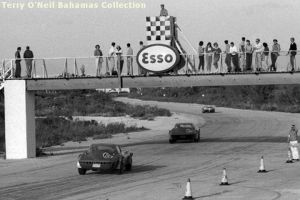
The #3 Grand Sport Corvette at speed in Nassau. Image: Terry O'Neil Bahamas Collection
Thanks to the on-track feedback that the engineers had gleaned from the races, they were able to improve on the two cars that had accumulated track time, as well as #5. That is when the iconic vents, slots, and flares were added to the three cars, giving them a very racy and aggressive look. These weren’t just for looks of course, but to attain less drag, improved cooling, and the ability to accommodate wider 9.5-inch wheels.
After their session of tweaking, cars #3, #4, and #5 were entered into the annual “Speed Week” at Nassau in December of ’63 rather sneakily. A Texan named John Mecom gladly handled this private and non-Chevrolet-associated venture, along with a few Chevrolet engineers who conveniently happened to be vacationing in the Bahamas around the same time.
On Sunday during the Tourist Trophy race, two of the cars experienced overheated differentials, still finishing rather well at 2nd and 3rd on grid. One of those vacationing engineers happened to be at the race to witness this problem, and must have accidentally grabbed the wrong bags headed out the door of the office, because he had three differential coolers on hand to equip the cars. What luck!
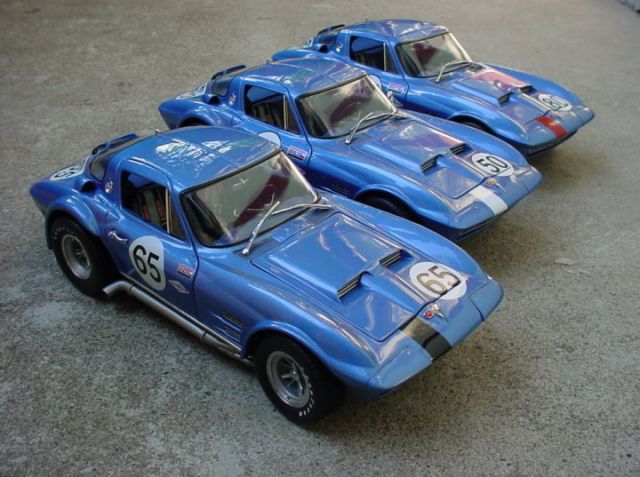
A trio of scale models depict the Mecom Racing Team Grand Sport Corvettes as they would have appeared in Nassau.
Far behind the Corvettes. Smiles were exchanged. During the final race on Sunday for the Nassau Trophy, the two cars that raced were able to secure 4th and 8th place, yet again, far ahead of the Shelby cars
The Daytona Endurance race in February of 1964 was next and in preparation the engineers decided to behead the #1 and #2 cars in order to reduce weight, drag, and frontal area. The hoods also received special attention by means of louvered blisters to allow trapped air underneath to escape, thus allowing the cars to stay better planted on the road at high speeds.
Where are they now?
You can safely bet that these cars don’t change hands very often. The last time a car went up for auction was in January of 2009, when the #2 GS failed to sell, despite reaching a $4.9 million bid.
Thanks go to John “Hutch” Hutchinson at GrandSportRegistry.com for providing the following information about the five cars’ current owners and locations:
#1: Harry Yeagy, Cincinnati, OH.
#2: Jim Jaeger, Cincinnati, OH. Now at Simeone Museum, Philadelphia, PA.
#3: Larry Bowman, Woodside, CA.
#4: Miles Collier, Naples, FL.
#5: Bill Tower, Plant City, FL.
You can safely bet that these cars don’t change hands very often. The last time a car went up for auction was in January of 2009, when the #2 GS failed to sell, despite reaching a $4.9 million bid.
- All five GS cars together in one picture, at the 2003 Amelia Island Concours . Chassis #1-5 in order, clockwise from left front. Image: Art Eastman
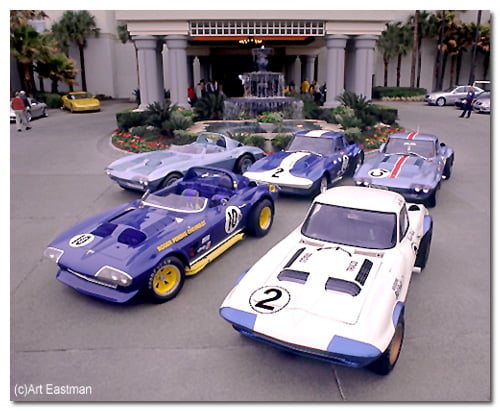
#1: Harry Yeagy, Cincinnati, OH.
#2: Jim Jaeger, Cincinnati, OH. Now at Simeone Museum, Philadelphia, PA.
#3: Larry Bowman, Woodside, CA.
#4: Miles Collier, Naples, FL.
#5: Bill Tower, Plant City, FL.
This time, the top brass at GM received tons of unwanted attention and criticism for this obvious support and backing of the racing project, and had to finally put a stop to it. Orders to destroy these five cars were issued, but the engineers who worked hard on these Corvettes were not about to allow such a crime to happen to their creations.
The three coupes had a surreptitious change of ownership to private and safer hands, while the two roadsters were secretly kept hidden within Chevrolet walls in Warren, Michigan before finally being sold to Penske in 1966.
A Brief, Shining Moment
So what makes these great cars so special, coveted, and memorable?
Beyond their rarity and racing history, perhaps it’s the fact that a group of inspired, die-hard Corvette enthusiasts at Chevrolet went against policy to dream up and develop a car to face the biggest competition in the racing world, all the while facing their own competition within their own company.
While we might lament what might have been, if the Grand Sport had attained the limited production status originally envisioned, we can be thankful that small cadre of Chevy engineers had the dedication and perseverance to write one of the most interesting chapters in GM racing history.
In a time when most automakers’ corporate decisions are made by accountants, not “car guys,” we’re fortunate to have this constellation of Grand Sport Corvettes to navigate by.
| . |

